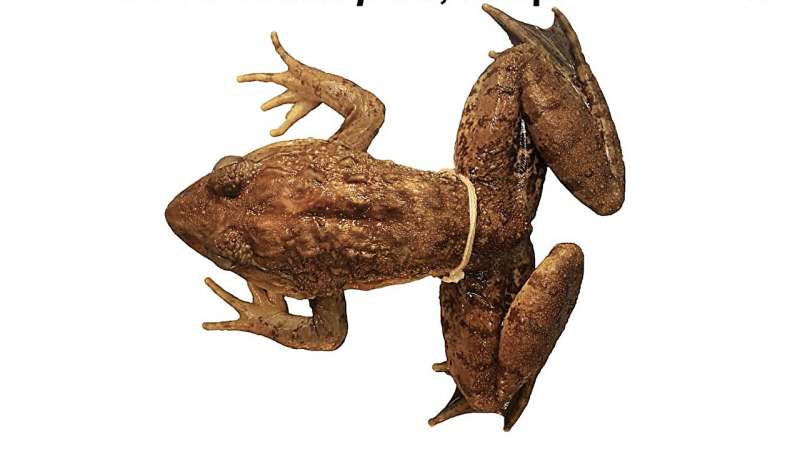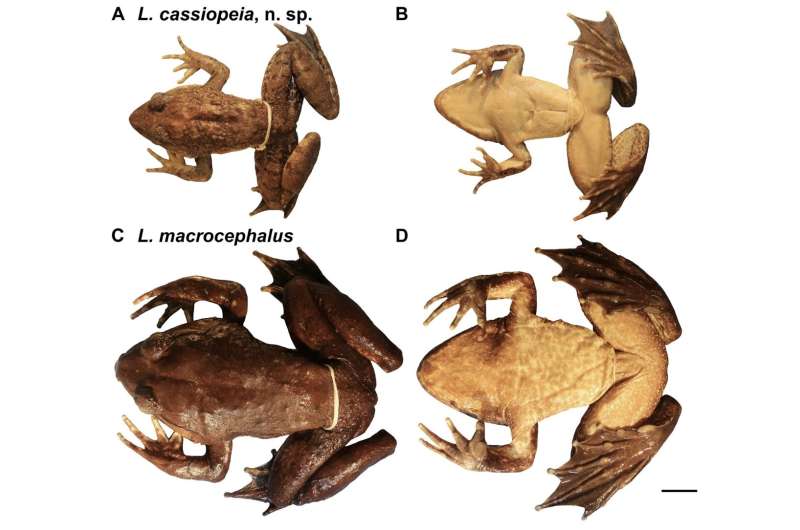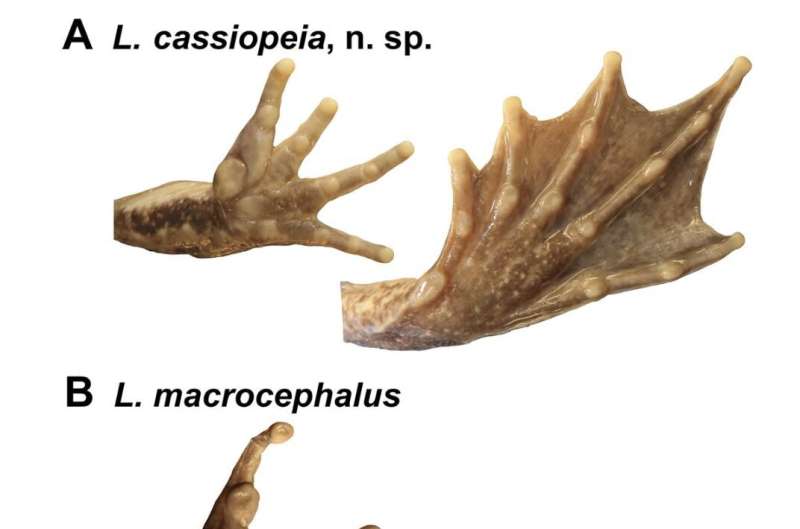This article has been reviewed according to Science X's editorial process and policies. Editors have highlighted the following attributes while ensuring the content's credibility:
fact-checked
trusted source
proofread
Genetic analysis reveals new giant fanged frog species in Philippines that is nearly identical to even larger species

Researchers from the University of Kansas have published findings in the journal Ichthyology & Herpetology describing a new species of fanged frog, named Limnonectes cassiopeia, from the Philippine island of Luzon.
Surprisingly, specimens of the new species have been collected a dozen times over the last 20 years, but all were mistakenly thought to be the juvenile version of the well-known, nearly identical (but not too closely related, it turns out) Luzon giant fanged frog.
"They're called that because the males of some species have large, bony protuberances, like fangs, in their lower jaw—it's pretty unique," said lead author Mark Herr, doctoral student at KU's Biodiversity Institute and Natural History Museum.
"It's still a bit of a mystery, but it's become generally assumed that these fangs are used for male-to-male combat. The males' fangs are much larger than the females. These males have big heads, and a lot of these frogs can be huge—some as large as chickens elsewhere in Southeast Asia."
At first, Herr identified Limnonectes cassiopeia while conducting a larger genetic survey of all Philippine fanged frogs, which includes a little over a dozen known species.
"I sequenced many of them to establish a good genetic dataset, allowing me to examine their patterns of relatedness," Herr said. "Many species were originally described, over the last century and a half, based solely on their physical appearance—before modern genetic analysis was available. In Luzon, there were two known species of fanged frogs: Limnonectes macrocephalus, the large one, and a medium-sized one called Limnonectes woodworthi. However, I discovered a different group next to macrocephalus that appeared in the genetic data as a distinct branch."
Finding this third, previously unknown species in the fanged frog genetic data prompted Herr to begin physical scrutiny of museum specimens, bolstered and guided by the attention-grabbing genetics. He hoped to see if he could tell any part of their morphology apart from the Luzon giant fanged frog, because the genetic analysis suggested they'd evolved rather independently.
Luckily, extensive work in the Philippines by Herr's KU faculty mentor Rafe Brown and previous generations of KU researchers meant there was an abundance of specimens at the KU Biodiversity Institute and Natural History Museum. Brown served as a co-author on the new paper along with KU master's student Hannah Som.

"I verified my genetic work to ensure there were no mistakes, and there were none," Herr said. "This led me to examine all the Limnonectes specimens from Luzon at the museum. We have hundreds of these frogs, and I carefully compared the 19 that had appeared in the new genetic cluster to those from the main cluster."
In straining to distinguish between physical traits of the two species, Herr said it was made easy to understand how they could be confused as the same species.
"I'm a herpetologist, I spend a lot of time looking at frogs—I looked at these things for a couple of weeks, just staring at them, trying to see if I could see something, and I couldn't," Herr said. "I couldn't see any major difference. It's not like one group is conspicuously colored, or visibly striped and the other isn't."
Herr began detailed measurements of the fanged frog specimens.
"We have a bunch of standardized measurements that are designed to find differences between populations—to see if differences reflect patterns of speciation," Herr said. "I ran comparisons among the populations, began to suspect they might represent different species, and then I delved further, with detailed comparisons of different characters against each other."
Finally, Herr arrived at his "big breakthrough" when he discovered the genetically distinct species all had smaller toe discs—and they were white.
"The discs are important," Herr said. "Statistically, in comparison to their body size, they may have smaller toe pads. So, I took all the genetically identified specimens back out again and found the key character—a simple physical trait that anyone can assess in the wild. If they catch one of these frogs, they can flip it over and tell right away. Not only are the toe pads smaller, but they're white. They're pale, completely unpigmented, which sets them apart from the primary species, Limnonectes macrocephalus, which has dark gray pigmented toe pads."

Herr said the unnoticed detail is even more remarkable because the frogs' home island is more densely populated than Great Britain.
"People from Luzon have been catching these frogs—the whole group—for 100-plus years," he said, adding they are part of the diet of several indigenous groups.
"They have these white discs. ... but I thought: Who would look at that? Who would think about it? Because we have these genetic resources, I now know there's something different about these frogs. I knew I should go see if that was real. The frogs are genetically divergent; so, I thought, let's see if this single trait corresponds to a major difference in their overall physical makeup, their size and shape—the way the frogs appear in physical space."
Indeed, Herr was reminded of the five-star constellation Cassiopeia by the new species' five white toepads, naming the new species Limnonectes cassiopeia.
Another major difference became apparent to Herr in time—that the new Limnonectes cassiopeia species developed its characteristic big head earlier in its development, from juvenile to adult, than Limnonectes macrocephalus.
"Obviously, the giant macrocephalus frogs overlap in size because they all start out really tiny, and you wouldn't be able to tell," he said.
"You'd just think these are all juvenile macrocephalus—that's what everyone who had caught one had thought for the last 25 years. But I did some measurements to determine that once the males start to reach sexual maturity, they get these big, wider heads and develop huge fangs. Sometimes, when we consider their use of fangs for combat, we see some big male Limnonectes with scars on their heads, presumably injuries from fighting. And my analysis showed that the big heads start to show up on this new genetic cluster at an overall smaller body size."
Now that the new species has been recognized, Herr hopes to learn more about its behavior in the wild and how it differs from Limnonectes macrocephalus.
"Now that we know they're different, we can go out and watch them and study their natural history and detail. Maybe they're doing something totally different in the wild, you know?" he said. "That's exciting for me."
More information: Mark W. Herr et al, A Long Overlooked New Species of Fanged Frog, Genus Limnonectes (Amphibia: Anura: Dicroglossidae), from Luzon Island, Northern Philippines, Ichthyology & Herpetology (2024). DOI: 10.1643/h2022094
Provided by University of Kansas





















